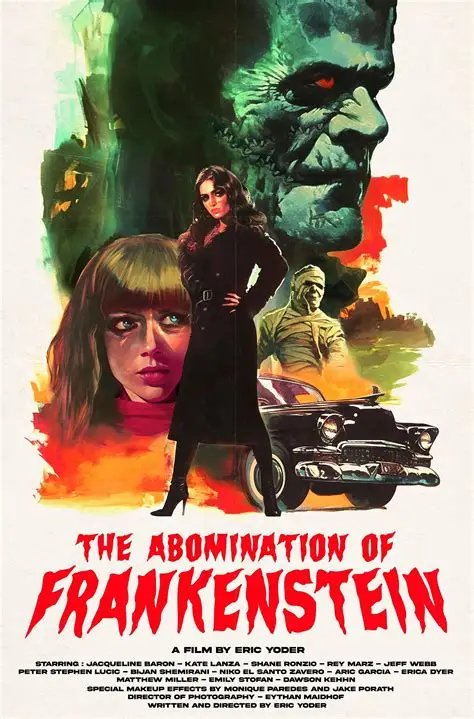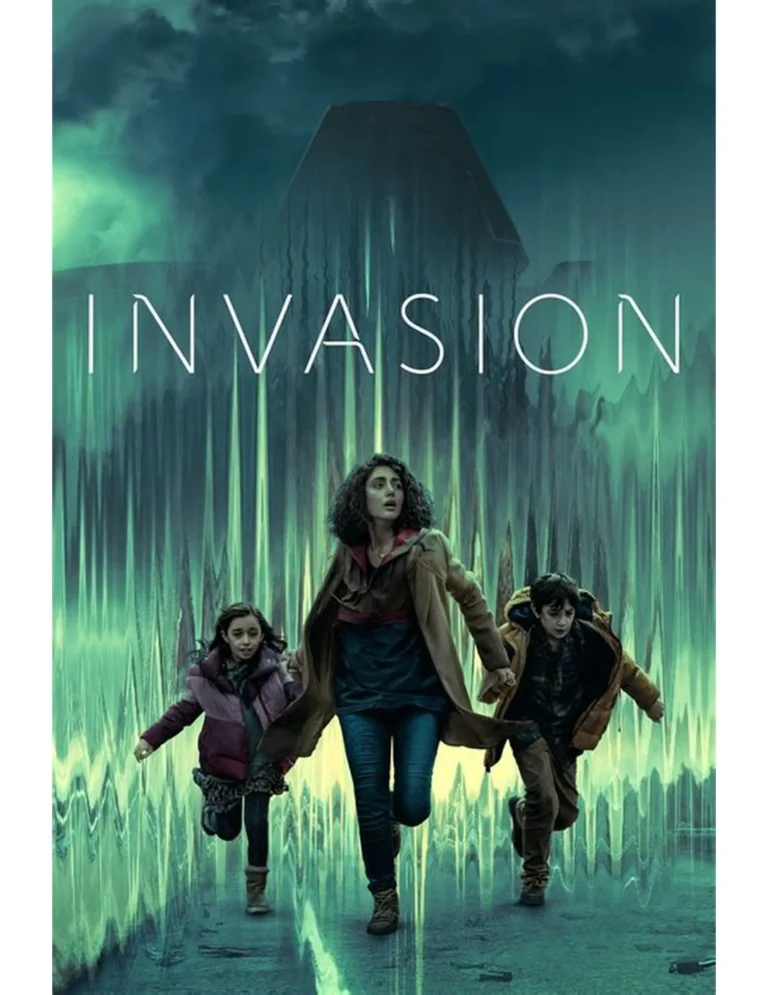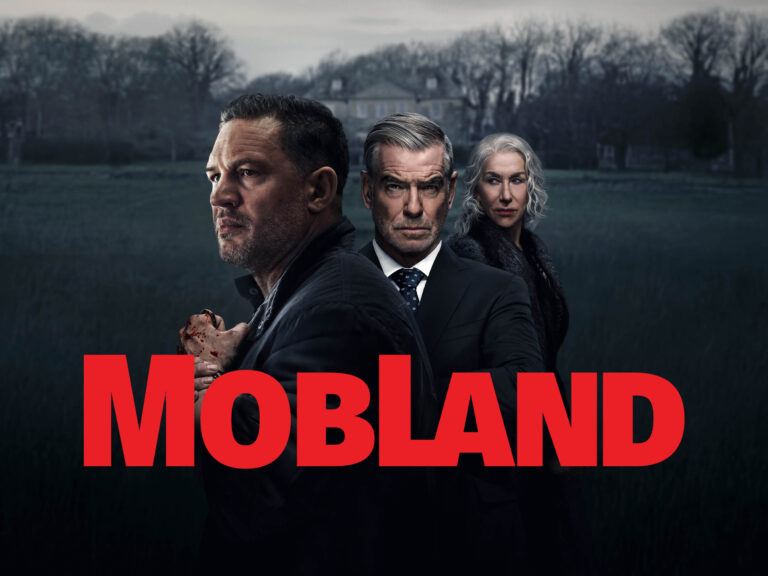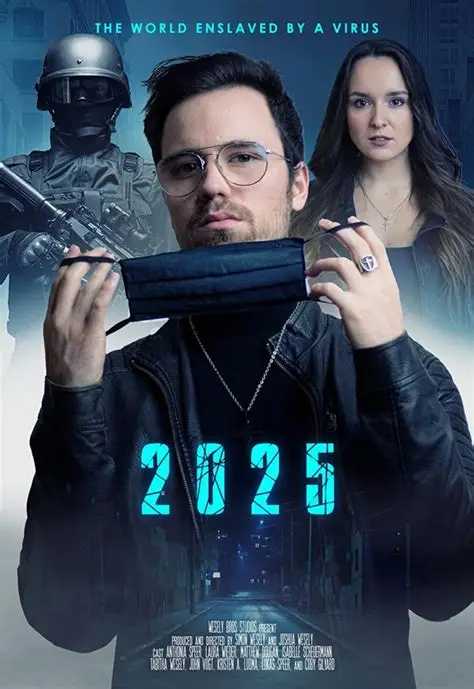
The World Enslaved by a Virus (2025)
The World Enslaved by a Virus (2025) is a German-language sci-fi film that delves into a dystopian future where a global pandemic has led to the rise of a single world government and the suppression of Christianity. Directed by Joshua Wesely and Simon Wesely, the film follows a group of young Christians in Germany as they form an underground movement to reunite believers and reclaim their freedom. The movie is set in the year 2025, showcasing a world transformed by the aftermath of the COVID-19 pandemic.
Movie Overview
2025: The World Enslaved by a Virus presents a chilling vision of the future, where the world has been reshaped by the events of the early 21st century. The film explores themes of faith, resistance, and the fight for freedom in an oppressive regime. Through its narrative, it raises questions about the balance between public health measures and personal liberties, all set against the backdrop of a global crisis.

Attribute Details
- Title: 2025: The World Enslaved by a Virus
- Genre: Sci-Fi, Dystopian
- Language: German
- Release Date: January 15, 2021
- Director: Joshua Wesely, Simon Wesely
- Writer: Joshua Wesely, Simon Wesely
Plot Summary
In the year 2025, the world has undergone significant changes due to the COVID-19 pandemic. A single world government has been established, and English has become the global language. Public gatherings are prohibited, travel is restricted, and Christianity has been banned. Amidst this backdrop, a small group of young Christians in Germany begins an underground movement to reunite believers and restore their freedom. They engage in acts of defiance, such as spray-painting Ichthys symbols on fallen leaves, to spread their message and inspire others to join their cause.
Main Cast
- Joshua Wesely as Roy
- Antonia Joy Speer as Hannah
- Matthew Dougan as Hunter
- Isabelle Scheuermann as Leila
- Coby Gilyard as Police IT
- Lukas Speer as Luc
- John Vogt as Interrogator
Production Details
The film was produced by Wesely Bros, a production company founded by the directors themselves. It was released on January 15, 2021, and has a runtime of 1 hour and 31 minutes. The movie is available for streaming on various platforms, including Amazon and Apple TV. Despite its modest production values, the film has garnered attention for its bold themes and controversial portrayal of a dystopian future shaped by the pandemic.
Reception
Upon release, 2025: The World Enslaved by a Virus received mixed to negative reviews. Critics have pointed out the film’s low-budget production, amateurish acting, and lackluster world-building. Some have criticized its portrayal of a dystopian future, describing it as unrealistic and heavy-handed. However, others have noted that the film’s themes resonate with current global concerns about freedom, faith, and governance. The movie has sparked discussions about the role of media in reflecting societal fears and the potential consequences of unchecked governmental power.
© 2025 Film Enthusiast. All rights reserved.
Symbolism and Imagery in the Film
One of the striking aspects of 2025: The World Enslaved by a Virus is its use of symbolism and visual storytelling. The film frequently uses the Ichthys symbol, a classic Christian emblem, as a motif of resistance and hope. The image of this symbol being discreetly painted or carved throughout scenes emphasizes the quiet yet persistent struggle of the underground believers. Additionally, the filmmakers use stark contrasts between sterile, controlled urban environments and the natural, unrestrained outdoors to highlight the tension between freedom and oppression. This visual storytelling reinforces the film’s themes of faith, courage, and the enduring human desire for spiritual autonomy, giving viewers subtle cues to understand the stakes without relying solely on dialogue.
Social Commentary and Relevance
While the film is set in a dystopian future, its themes reflect contemporary societal concerns. 2025: The World Enslaved by a Virus comments on the balance between public health measures and personal freedoms, exploring how governments can overreach during crises. The suppression of Christianity and restriction of individual liberties mirror real-world debates on civil rights and surveillance, prompting viewers to reflect on the ethical and moral implications of centralized authority. By embedding these social questions within a science-fiction narrative, the film challenges audiences to consider their own values and the consequences of complacency in the face of systemic control. It blends entertainment with thought-provoking discourse, making the film culturally and politically resonant.
Character Development and Emotional Depth
The characters in the film are not just archetypes; they evolve and confront moral dilemmas that give emotional weight to the story. Roy, Hannah, and the rest of the group face internal conflicts as much as external threats, showing the struggle between fear, loyalty, and conviction. Their relationships, moments of doubt, and acts of bravery allow viewers to connect with them on a human level. The filmmakers intentionally focus on intimate character moments, often set against oppressive backdrops, to illustrate how personal faith and ethical choices persist even when society collapses. These developments provide a deeper understanding of human resilience, emphasizing that even in a tightly controlled dystopia, individuals can assert their identity and beliefs.
Music and Sound Design
Another underrated aspect of 2025: The World Enslaved by a Virus is its music and sound design. The soundtrack combines haunting electronic tones with subtle orchestral cues, creating an atmosphere of suspense and unease. Ambient sounds, such as the hum of surveillance technology or the quiet rustling of nature, reinforce the tension between confinement and freedom. The sound design is carefully calibrated to immerse viewers in the film’s oppressive environment while also emphasizing moments of hope and defiance. These auditory choices enhance storytelling by supporting emotional arcs, creating a more layered and engaging cinematic experience.
Global and Cultural Implications
Though primarily set in Germany, the film’s dystopian scenario has global implications. It imagines a world where pandemics, centralized control, and cultural homogenization have eliminated diversity and restricted freedoms worldwide. By showing the consequences of such global changes, the film encourages viewers to consider the importance of preserving cultural identities and religious freedoms. The narrative raises questions about globalization, technological surveillance, and the erosion of personal autonomy, making it a cautionary tale that resonates across borders. This broader perspective adds depth to the story and elevates it from a localized narrative to a universally relevant cautionary tale.
Viewer Takeaways and Reflections
Ultimately, 2025: The World Enslaved by a Virus encourages introspection about freedom, morality, and belief systems. Viewers are invited to reflect on their own values, the fragility of liberties, and the ways in which society responds to crises. The film’s combination of dystopian tension, symbolic imagery, and personal stories of courage makes it memorable and thought-provoking. It challenges audiences not just to watch but to think critically about authority, resistance, and the choices individuals must make when confronted with oppressive circumstances. By leaving viewers with these reflections, the film extends its impact beyond entertainment, serving as both a narrative and a philosophical experience.
Behind the Scenes: Filming Challenges
The production of 2025: The World Enslaved by a Virus faced significant challenges due to its ambitious dystopian setting and limited budget. Filming locations were carefully selected to convey a sense of oppression and isolation, often using empty streets and abandoned buildings to depict a world under strict government control. The crew had to work around lighting and weather constraints to maintain consistency, especially in outdoor sequences that symbolized freedom and rebellion. Despite these limitations, the directors creatively used practical effects and minimalistic set design to immerse viewers in the story. These behind-the-scenes efforts highlight the dedication and resourcefulness of the filmmakers, proving that impactful storytelling can be achieved even without massive studio resources.
Visual Effects and Cinematic Techniques
Although the film had a modest budget, it makes striking use of visual effects and cinematic techniques to enhance the dystopian atmosphere. The filmmakers employed color grading to create a cold, sterile aesthetic for government-controlled areas, contrasting it with warmer, more natural tones in scenes of resistance and free expression. Camera angles and movements were carefully designed to emphasize tension, often using tight frames to evoke claustrophobia and surveillance. Minimal CGI was used strategically to depict futuristic technology and public monitoring systems, ensuring realism without appearing artificial. These techniques contribute to the immersive quality of the film, allowing viewers to feel the oppressive environment while rooting for the protagonists’ struggle.
Real-Life Inspirations and Context
The narrative of 2025: The World Enslaved by a Virus draws clear inspiration from real-world events and societal debates. The film extrapolates the global impact of the COVID-19 pandemic, exploring how governments might respond to crises and the potential consequences for personal freedoms. Themes of surveillance, social restriction, and religious oppression mirror discussions happening in contemporary society about the balance between public health and civil liberties. By grounding its dystopian scenario in recognizable realities, the movie makes its story more compelling and relevant. Viewers are encouraged to reflect on how history, policy, and technology intersect, and what could happen if societal freedoms are increasingly compromised in the name of safety or order.
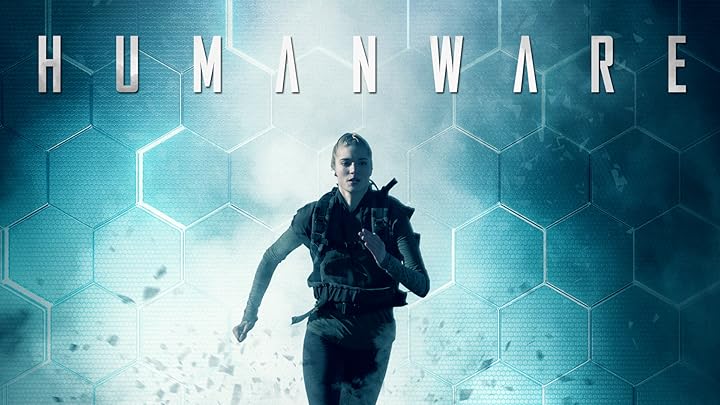
Audience Engagement and Cultural Impact
The film has resonated with niche audiences who are drawn to dystopian narratives and ethical dilemmas. Discussions around 2025: The World Enslaved by a Virus often focus on the moral and philosophical questions it raises rather than its entertainment value alone. Viewers have debated the implications of government control, the importance of religious freedom, and the personal responsibility of individuals in oppressive circumstances. The movie has sparked conversations online, especially among communities interested in speculative fiction, ethical debates, and faith-based storytelling. Its cultural impact lies in provoking thought and dialogue, showing that independent films can influence public discourse and inspire reflection on societal issues.
Costume and Set Design as Narrative Tools
The costume and set design in the film serve as critical narrative tools, reflecting the oppressive nature of the world in 2025. Characters in government-controlled areas are often dressed in muted, uniform-like clothing, symbolizing conformity and loss of identity. In contrast, members of the underground resistance wear personalized, practical attire that signals individuality and defiance. Similarly, the sets are intentionally stark and minimal in public spaces, creating a sense of surveillance and control, while natural outdoor scenes are lush and unconfined, representing freedom and hope. These deliberate choices enhance the storytelling by visually reinforcing the themes of oppression, rebellion, and the human desire for autonomy.
Philosophical and Ethical Questions
Beyond its narrative, 2025: The World Enslaved by a Virus raises significant philosophical and ethical questions. What happens when safety and control come at the cost of freedom? How far should individuals comply with authority when personal beliefs and morals are threatened? The film challenges audiences to consider these dilemmas in the context of their own lives, encouraging introspection about authority, morality, and social responsibility. By embedding these questions within a dystopian storyline, the filmmakers transform entertainment into a medium for philosophical inquiry, making the movie not just a visual experience, but also an intellectual one that prompts meaningful discussion.
Narrative Structure and Storytelling Techniques
The narrative of 2025: The World Enslaved by a Virus is structured to create tension and maintain audience engagement throughout the film. The story alternates between the oppressive daily life under government control and the secret activities of the underground Christian movement, giving viewers a dual perspective on both compliance and resistance. Flashbacks are used sparingly to provide context for the characters’ pasts, motivations, and faith journeys, which enriches the emotional depth of the film. This non-linear storytelling approach keeps the audience invested while gradually revealing the stakes and moral dilemmas faced by the protagonists, allowing for suspense and reflection on the larger societal implications of the plot.
Thematic Symbolism and Hidden Messages
The film is rich in symbolic imagery that reinforces its central themes of resistance, faith, and freedom. Beyond the recurring Ichthys symbol, light and shadow play a significant role in communicating the story’s underlying messages. Scenes dominated by harsh artificial light often represent oppression and surveillance, while softer, natural lighting is used in moments of hope and solidarity among the resistance. Objects such as fallen leaves, closed doors, and locked windows are used metaphorically to represent barriers to freedom and opportunities for rebellion. These visual cues encourage viewers to interpret the story on multiple levels, deepening their engagement with the narrative and its moral undertones.
Technology as a Tool of Control
Technology is depicted in the film not just as a neutral tool, but as a mechanism of control and surveillance. Government-issued devices, monitoring cameras, and communication restrictions illustrate how technological advancements can be exploited to limit freedom and track individual movements. The film emphasizes that while technology can enhance efficiency and safety, it also carries ethical responsibilities that, if ignored, can lead to oppression. By highlighting this duality, the film prompts viewers to consider the impact of surveillance, data collection, and digital monitoring in their own lives, making the story both futuristic and highly relevant to contemporary society.
Psychological Tension and Emotional Stakes
The film builds psychological tension by exploring the mental and emotional pressures experienced by the characters. Constant fear of discovery, the struggle to maintain faith in an oppressive environment, and the weight of responsibility on young leaders create a palpable sense of anxiety. The directors use close-up shots and deliberate pacing to allow audiences to experience the internal conflicts of the characters firsthand. Emotional stakes are further heightened when relationships within the resistance are tested, revealing betrayals, doubts, and moments of courage. This focus on psychological realism ensures that the audience is not only witnessing a dystopian story but is emotionally invested in the characters’ survival and moral choices.
Societal Critique and Contemporary Relevance
2025: The World Enslaved by a Virus functions as more than a dystopian narrative—it is a critique of contemporary society’s handling of crises and authority. By extrapolating a future where freedoms are curtailed and religious practices are banned, the film highlights the tension between public safety and individual liberty. It challenges viewers to reflect on the balance of power, the potential dangers of unchecked governmental authority, and the importance of civic engagement. Through its dystopian lens, the film offers a cautionary tale about societal complacency, encouraging audiences to consider how personal and collective choices shape the future.
Symbolic Use of Nature and the Environment
The film often juxtaposes the natural world against sterile, controlled environments to underscore the themes of freedom versus oppression. Scenes set in parks, forests, and open landscapes symbolize liberation and spiritual renewal, while urban environments dominated by concrete, surveillance cameras, and restricted movement convey confinement and control. The recurring use of environmental imagery reinforces the message that true freedom is not only spiritual but also connected to the natural world. This approach adds a layer of metaphorical meaning, showing how human resilience and hope often find expression through interaction with nature even in the darkest circumstances.
FAQs about 2025: The World Enslaved by a Virus
1. What is 2025: The World Enslaved by a Virus about?
The film depicts a dystopian future where a global pandemic leads to a single world government and strict suppression of Christianity. It follows a group of young Christians in Germany who form an underground resistance to fight against oppressive authority and restore their freedom. Themes of faith, courage, and resilience are central to the narrative.
2. Who directed the film?
The movie was directed by Joshua Wesely and Simon Wesely, who also contributed to the writing and production. Their vision was to create a low-budget but impactful dystopian story with strong moral and philosophical themes.
3. Who are the main actors?
The main cast includes Joshua Wesely as Roy, Antonia Joy Speer as Hannah, Matthew Dougan as Hunter, and Isabelle Scheuermann as Leila. Supporting roles are played by Coby Gilyard, Lukas Speer, and John Vogt.
4. What genre does the film belong to?
The movie is primarily a sci-fi dystopian film, blending elements of thriller and faith-based drama. It explores speculative social scenarios while highlighting ethical and moral dilemmas.
5. What language is the film in?
The original language of the film is German, reflecting its setting in Germany and authentic portrayal of the characters’ culture and environment.
6. When was it released?
2025: The World Enslaved by a Virus was released on January 15, 2021, and is available on streaming platforms such as Amazon and Apple TV.
7. How long is the film?
The runtime of the film is 91 minutes, allowing it to convey its complex story concisely while maintaining tension and engagement.
8. What is the central theme of the film?
The central theme revolves around the struggle between authoritarian control and individual freedom, particularly focusing on faith, personal integrity, and moral responsibility in a dystopian world.
9. Is the film based on real events?
While the plot is fictional, it draws inspiration from real-world events, especially the societal impact of the COVID-19 pandemic, debates on civil liberties, and the role of global governance in crisis situations.
10. How does the film portray government control?
The government in the film is shown as authoritarian and highly surveilled, restricting public gatherings, monitoring communications, and banning religious practices. This serves as a cautionary depiction of the dangers of unchecked power.
11. What role does Christianity play in the film?
Christianity represents both spiritual freedom and the ethical resistance against oppression. The underground movement of believers highlights courage, faith, and moral conviction in the face of totalitarian control.
12. What kind of visual style does the film use?
The visual style contrasts sterile, cold government-controlled spaces with warmer, natural environments representing hope and freedom. Color grading, lighting, and camera angles are used strategically to emphasize oppression versus rebellion.
13. Who wrote the film?
Joshua Wesely and Simon Wesely wrote the screenplay, combining dystopian storytelling with philosophical and faith-based reflections.
14. How are the characters developed?
Characters evolve emotionally and morally throughout the film, facing internal dilemmas and external threats. Their personal growth emphasizes resilience, leadership, and the struggle to maintain integrity under pressure.
15. What challenges did the production face?
Filming faced challenges due to budget constraints, limited access to locations, and the need to portray a futuristic dystopia realistically. Creative set design, practical effects, and careful planning were used to overcome these obstacles.
16. Does the film include special effects?
Yes, minimal CGI was used to enhance surveillance technology and futuristic elements, while practical effects conveyed the controlled environment and resistance activities effectively.
17. How is music used in the film?
The soundtrack combines ambient electronic tones with subtle orchestral elements to enhance suspense and emotion. Sound design emphasizes both tension and moments of hope, contributing to immersion.
18. What philosophical questions does the film raise?
The film prompts viewers to consider the balance between authority and individual freedom, ethical responsibility, the limits of compliance, and the consequences of societal complacency.
19. How does the film depict resistance?
Resistance is shown through underground movements, covert symbols, secret meetings, and personal acts of defiance. These strategies highlight courage and unity in the face of oppression.
20. Are there any notable symbolic elements?
Yes, the Ichthys symbol is used repeatedly to represent faith and rebellion. Light and shadow, nature versus urban environments, and other visual cues reinforce the central themes of freedom, hope, and moral resilience.

21. How is suspense created?
Suspense arises from constant surveillance, moral dilemmas, close encounters with authority, and the uncertainty of the resistance’s success. Tight camera angles and pacing amplify tension.
22. Who produced the film?
The film was produced by Wesely Bros, the directors’ own production company, emphasizing creative control and low-budget independent filmmaking.
23. What is the target audience?
The film primarily appeals to viewers interested in dystopian narratives, speculative fiction, faith-based themes, and ethical debates about freedom and government control.
24. How has the film been received?
Critics and audiences have given mixed reviews. Praise is given for its themes and ambition, while criticism focuses on production quality and acting. It is appreciated for sparking conversation on societal issues.
25. Can viewers relate it to current events?
Yes, the film mirrors global discussions about public health, surveillance, civil liberties, and religious freedoms, making it relevant and thought-provoking in today’s context.
26. Does the film use flashbacks?
Flashbacks are used sparingly to provide background on characters’ past experiences, motivations, and faith journeys, adding emotional depth to the story.
27. How is technology portrayed?
Technology is depicted as a tool of control, monitoring citizens, restricting movement, and suppressing communication. It emphasizes the dual role of technology as both beneficial and potentially oppressive.
28. How does nature function symbolically?
Nature symbolizes freedom, hope, and human resilience, contrasted against sterile urban environments that signify oppression and restriction. Scenes in parks and forests often coincide with moments of personal or spiritual triumph.
29. Are there moral lessons in the film?
The film teaches lessons about courage, ethical responsibility, the importance of faith, and standing up for one’s beliefs despite societal pressures and risks.
30. Is there any romance in the film?
While the film primarily focuses on resistance and faith, interpersonal relationships are explored to add emotional stakes. However, romantic elements are secondary to the main plot.
31. Does the film have sequels planned?
As of now, no official sequels have been announced. However, the film’s ending leaves room for potential continuation of the story and further exploration of its dystopian world.
32. What is the cinematography style?
Cinematography emphasizes contrast between oppressive and liberating environments, with tight frames for tension and wide shots for freedom. Color grading and lighting reinforce the emotional and thematic layers of the story.
33. What platforms is the film available on?
The movie is available for streaming on platforms like Amazon Prime Video and Apple TV. It can also be purchased digitally for home viewing.
34. Does the film depict violence?
Violence is minimal and mostly implied, focusing instead on psychological tension, oppression, and ethical dilemmas rather than graphic content. The film relies on suspense and moral conflict to create drama.
35. What is the key takeaway from the film?
The key takeaway is the resilience of the human spirit in the face of authoritarian control. It emphasizes faith, courage, and the importance of maintaining personal and moral integrity even when societal pressures threaten freedom.
